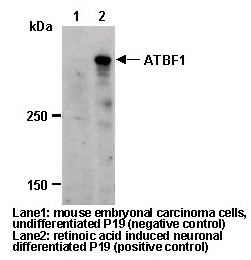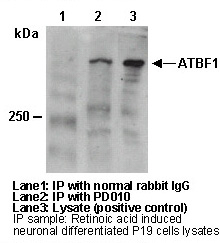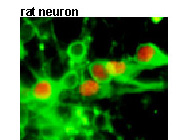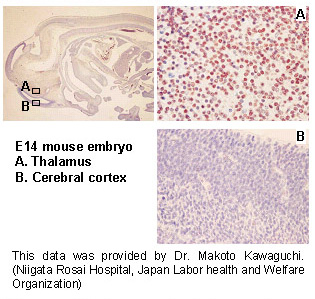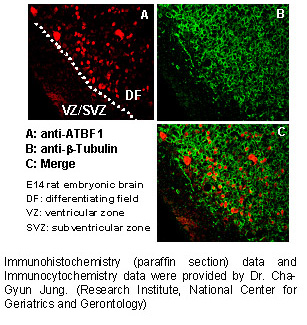This site is for customers in Asia.
Customers in China & other regions, please go to Global page.
HOME >
Product search results > Code No. PD010
Anti-ATBF1 (D1-120) pAb
Availability (in Japan)
10 or more
(In Japan at 00:05,
Apr 24, 2024 in JST)
Size
100 µL
| Data | |||||
|---|---|---|---|---|---|
| Clonality | Polyclonal | Clone | Polyclonal | ||
| Isotype (Immunized Animal) | Rabbit IgG | ||||
| Applications | |||||
| Immunogen (Antigen) | recombinant region of human ATBF1 (2107-2147 aa.) corresponding to the identical amino acid sequence of mouse ATBF1 (2114-2154 aa.) | ||||
| Reactivity [Gene ID] | |||||
| Storage buffer | PBS/50% glycerol, pH 7.2 | ||||
| Storage temp. | -20°C | Conjugate | Unlabeled | Manufacturer | MBL |
| Alternative names | ZFHX3, ATBT, ZNF927 | ||||
| Background | ATBF1 (also known as ZFHX3) is a transcription factor that has two-protein isoforms, the 404 kDa ATBF1-A and the 306 kDa ATBF1-B. ATBF1-A contains four homeodomains and 23 zinc-finger motifs. ATBF1-B contains four homeodomains and 18 zinc fingers. ATBF1 is identified as DNA-binding protein, which binds to an AT-rich element of the human α-fetoprotein (AFP) gene, as a result suppressing its transcription activity. ATBF1 is also involved in cell cycle arrest and cooperating with p53 to activate the p21Waf1/Cip1 promoter. ATBF1 is expressed in the differentiation fields in association with β-tubulin III and MAP2 that are the neuronal differentiation marker. ATBF1 plays a crucial role in neuronal development and cell cycle arrest. |
||||
| Related products | PD011 Anti-ATBF1 (AT-6) pAb |
||||
| Citations |
Western Blotting
Immunocytochemistry
Immunohistochemistry
Immunofluorescence
|
||||
| Product category |
|
||||
- The availability is based on the information in Japan at 00:05, Apr 24, 2024 in JST.
- The special price is shown in red color.
- Please note that products cannot be ordered from this website. To purchase the items listed in this website, please contact us or local distributers.
- Abbreviations for applications:
WB: Western Blotting, IH: Immunohistochemistry, IC: Immunocytochemistry, IP: Immunoprecipitation
FCM: Flow Cytometry, NT: Neutralization, IF: Immunofluorescence, RIP: RNP Immunoprecipitation
ChIP: Chromatin Immunoprecipitation, CoIP: Co-Immunoprecipitation - For applications and reactivity:
*: The use is reported in a research article (Not tested by MBL). Please check the data sheet for detailed information.
**: The use is reported from the licenser (Under evaluation or not tested by MBL).
- For storage temparature: RT: room temparature
- Please note that products in this website might be changed or discontinued without notification in advance for quality improvement.












 Citations
Citations Data Sheet
Data Sheet
